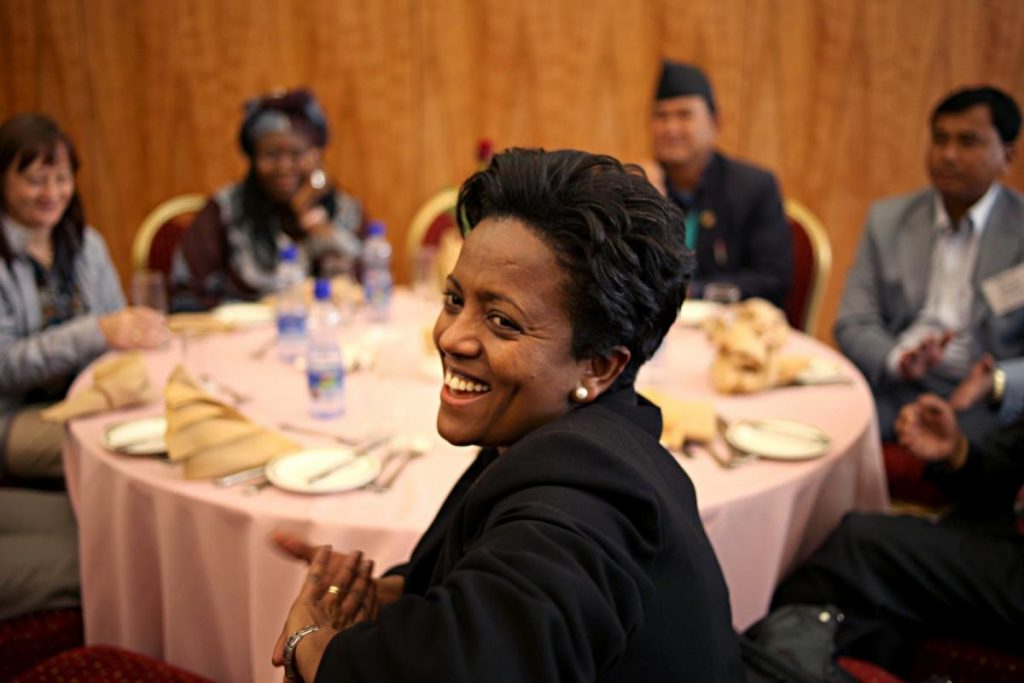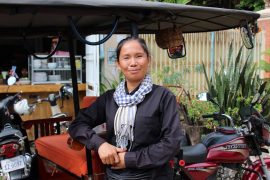Rising figures of people living with HIV/AIDS has for some time been a huge source of concern for governments of developing nations, health workers and well-meaning individuals. As part of efforts towards fighting this disease which has become a menace to society, the Organization of African First Ladies Against HIV/AIDS (OAFLA) was formed. OALFA has left no stone unturned in seeking new methods through which HIV/AIDS and other related diseases can be reduced to the barest minimum.
In an exclusive interview with Amazons Watch Magazine, the First Lady of the Federal Democratic Republic of Ethiopia, and President-Elect of the Organization of African First Ladies against HIV/AIDS Her Excellency, Roman Tesfaye, speaks on some of the achievements of the OALFA and the Ethiopian government in the fight against deadly diseases, and the creation of a better healthy life for all. Excerpt:
Your Excellency, please tell us some of the progress your country has made in the fight against cancer.
My country has made significant strides in the fight against communicable diseases, which has laid the foundation for the aspiration to end AIDS, tuberculosis, and malaria by 2030. However, non-communicable diseases including cancer are rising rapidly in our country causing immense sufferings and deaths. In response to these, measures are being taken at different levels. The first progress made was consensus created at the policy level to give due attention to fighting cancer and other NCDs as we are bearing double burden of diseases. Following this, we have established the national cancer control steering committee comprising of key stakeholders and co-chaired by the Minister of Health and myself to coordinate and lead the response. Then, our country’s first national cancer control plan was developed for a 5-year period from 2016-2020 under the leadership and close follow up of the committee. The plan calls for cancer control in a continuum of care model- primary prevention, early detection, treatment and palliative care using existing health system.
With only one cancer centre at Black Lion hospital in Addis Ababa for a country with a population of over 100 million, we have been exerting concerted efforts to create access to services. Currently, five new comprehensive cancer centres are being established within University Hospitals in the five corners of the country while upgrading the existing centre at Black Lion hospital by replacing cobalt-60 with LINAC radiotherapy machine. Constructions of sites for radiotherapy machines are completed in the first three university hospitals- Black Lion, Jimma, and Haromaya. LINAC radiotherapy machines are getting shipped and installed at these hospitals. Site constructions in the remaining three university hospitals- Hawassa, Gondar, and Mekelle are 70-75% complete and their LINAC radiotherapy machines to be shipped as the sites get ready. To avail the required human resources for the new centres, we are planning to import expatriates in short-terms while building in-country human resources capacity as long term solution. Meanwhile, a health centre in Addis Ababa was equipped with 50 beds capacity to provide inpatient and outpatient services as an extension of Black Lion Cancer Center.
As breast cancer is the most prevalent cancer in the country, a guideline was developed by Ministry of Health to decentralize breast cancer diagnosis and treatment with chemotherapy by task shifting to non-oncologist medical doctors in referral hospitals with mentorship and referral links with the existing centre. In addition, a demonstrative project is to commence in collaboration with Pink Ribbon Red Ribbon at Hawassa University referral hospital to establish a centre of excellence for breast cancer diagnosis and management in a health network with catchment health facilities. The lessons to be used for scaling up breast cancer services across the nation. To combat cervical cancer, a national guideline was developed and over 195 health facilities across the country are providing screening for pre-cancerous lesions using visual inspection with acetic acid (VIA) and treatment with Cryotheraphy machines. About 76,000 women screened for cervical pre-cancer lesions. To enhance the utilization of services, we will have a sub-national campaign in the areas with Cryotheraphy machines. Additional Cryotheraphy machines are under procurement to avail at least one Cryotheraphy machine at every woreda (district) throughout the country. Once, the Cryotheraphy machines are availed and personnel trained in their operation, we will launch a national campaign for population-based screening for cervical pre-cancer lesions and treatment with Cryotheraphy. For cervical pre-cancer lesions requiring operations, 16 Loop Electrosurgical Excision Procedure (LEEP) providing sites are equipped and staffed with trained professionals to provide services at referral hospitals. Moreover, a demonstration project of vaccination against HPV for young school girls aged 9-13 years was undertaken in two woredas in Tigray and Oromiya regions of our country. Now it is decided to have a nationwide scale-up of vaccination against HPV. To enhance the affordability of oncology drugs, a policy of 50% subsidy was put in place with no mark up at all levels of supply chain system. As 40% of cancer can be prevented by modifying risk factors, we are to ignite a public movement to avoid smoking, harmful use of alcohol, unhealthy diet, and physical inactivity.
It has been nearly two (2) years since the National Cancer Control Plan was launched in Ethiopia. How will you rate the accomplishments of the plan?
We have no clear national cancer control program and it is integrated into health sector transformation strategic plan and operational plans at national and regional levels. This is a great achievement at policy and program planning levels. We are also undertaking major expansions of cancer centres through joint efforts of government and development partners, which will result in dramatic improvements in access to comprehensive cancer control services. Breast cancer and cervical cancer services are getting expanded though not at anticipated pace. Overall, we are at an encouraging start of implementation with achievements instilling hope to fight cancer in resource-constrained settings like ours to avoid preventable sufferings and deaths.
Your Excellency; last month, you were elected President of the Organization of African First Ladies Against HIV/AIDS (OAFLA). Under your leadership, what impact or difference would you like OAFLA to make in Africa in terms of tackling some of the region’s peculiar challenges?
Together with my fellow first ladies, I will advocate for bringing socio-economic transformation across the continent as envisioned in Africa’s development agenda of 2063. We will document and share best lessons in the fight against HIV/AIDS and other major communicable diseases, combating cervical, breast and prostate cancers, ending child marriage, improving maternal and child health, promoting girls education, better nutrition, and women economic empowerment through strong country leadership and ownership, active community engagement, accelerated services expansion and utilization, and enhanced mobilization of local and global resources in a shared sense of responsibility.
Ethiopia has made some progress in terms of increasing access to HIV prevention and treatment services, among pregnant women living with HIV and children. Your efforts in achieving this feat have been quite tremendous. Please, tell us about your recent involvement in the fight against HIV/AIDS in Ethiopia.
Ethiopia has achieved encouraging results in the fight against HIV/AIDS with a 90% decline in new HIV infection as compared to the 2001 baseline. However, the epidemic remained heterogeneous among geographic areas and population groups. My recent efforts in the fight against HIV/AIDS focused on Gambella, Benshangul Gumuz, and Ethiopian Somali regional states. Gambella region has the highest HIV prevalence (6.5%) in our country as compared with the national HIV prevalence of 1.5%. Young girls aged 15-24 in Gambella regional state have HIV prevalence of 9% which is much higher than the national HIV prevalence of 0.5% among girls in the same age group. Young boys in the region have much lower HIV prevalence (0.2%) indicating sexual mixing of young girls with older men having higher risks. We have conducted a series of advocacy conferences in the region including the national celebration of WAD 2014 in Gambella town. In the event, over 3800 people were tested for HIV in a single day at one site and we got registered in the Guinness Books of Records for the achievement. Currently, Gambella HIV/AIDS program has become a flagship initiative at the national level. But, we have observed that the momentum is not sustained after mobilization events.
By drawing in-country lessons from other regional states, we are advocating to systematize the response in the region by strengthening leadership and ownership at all levels, creating a shared vision to halt and reverse the epidemic, having clear activity plans and targets to be achieved at every level to be entered into performance agreements with a shared sense of responsibility and accountability. Public movement in the communities to be ignited using health extension workers as facilitators of community conversation in which community members dialogue and create consensus not only on the severity of the problems but also on fueling factors of the epidemic in their setups and ways of preventing and controlling them. At the end of the conversation sessions, the community members are to come up with concrete action plans to be implemented and monitored including issuing community bylaws to end widow inheritance, avoid child marriage, stop stigma and discrimination, adopt pre-marital HIV testing, promote utilization of HIV services and enhance the provision of care & support to the needy PLHIVs, orphans and vulnerable children. Likewise, the response will be intensified in Benshangul Gumuz and Ethiopian Somali regional states.
My efforts also focus on pocket areas in other regions of the country where a significant number of most at risk and highly vulnerable population groups live which includes large scale development schemes- mechanized farms, road constructions sites, houses, and power generation dams, and transport corridors as our country aspire to end AIDS by 2030.
Your school feeding programme initiated in 2015 as a strategy for encouraging children to school, has gained acceptance, at the government level, and received support both at local and international levels. Please tell us about the successes and accomplishments of the national school feeding programme.
A study conducted in our capital Addis Ababa at public primary schools has indicated that the academic performance of primary school children from poor families is highly affected due to malnutrition. Starved children showed high absenteeism, poor attendance, high dropouts, and low academic performance including repetitions. Some of them carried empty lunch boxes to pretend as if they have something to eat and get away from their fellow classmates not to be seen during lunchtimes. This is hindering their ability to develop to their full potential and get out of poverty. When I recognized this reality, I was in deep sorrow, my heart broken as a mother and citizen. I began thinking about what can be done to help these destitute children today to secure their bright future through education. Then, we established a local NGO named ‘Ye Enat Weg’ literally meant motherly custom, to manage the school feeding program. The charity organization is working with city education bureau, school feeding committee in each public primary school and bureau of women and child affairs. We mobilized funds from local and international sources. The school feeding program which started in 98 public primary schools and fed 5,010 needy school children in 2015 is now benefiting over 20,000 school children in 208 public primary schools in all sub-cities of our capital. The beneficiary students’ academic performance has improved markedly. About a third of them ranked 1 to 3 in their classes. Encouraged by the achievements, we are planning to expand ‘Ye Enat Weg’ project to two regions of the country. The lessons from the school feeding program to be used for nationwide scale-up in the future. Currently, the Ministry of education is drafting a national school feeding strategy.
Early marriage and pregnancy are challenges faced by many teenage girls across developing nations. The Demographic and Health Survey data from 2011 put the median age at which Ethiopian women marry at 16.5 years, revealing that 40% of all women in their early 20’s were married before the age of 18. What are some of your efforts and that of your country to address this trend in Ethiopia?
Median age at first marriage among women aged 25-49 years in Ethiopia has increased from 16 years in 2000 to 17.1 years in 2016. On the other hand, the proportion of women aged 15-19 years old married has declined from 14.4% in 2000 to 5.7% in 2016. This is encouraging progress but we need to intensify our efforts to stop child marriage and pregnancy by addressing the underlying causes besides providing youth-friendly services. These include promoting women’s economic empowerment, girls’ education and avoiding harmful traditional practices including child marriage.
Empowering women economically builds their self-esteem, enhances their values within their families and communities. It not only improves women’s income but also the livelihood of households as women often spend money on the things that improve the wellbeing of their families with positive social outcomes. I have launched an initiative to link 1500 women-led entrepreneurs to the export market with value chain links to women at the grassroots. Their export products include precious stones, handicrafts, leather goods, fashion products, value-added coffee, and coffee-honey. At a broader scale, the government has developed and issued women’s development package which includes awareness creation, building women’s capacity for leadership and business skills, linking with small and micro-enterprises development institutions, seed money, and markets.
As education is an instrument to speed up socio-economic development and break the vicious cycle of poverty, we have been making unwavering efforts to ensure access to primary education to all. As a result, Ethiopia has attained almost universal enrollment to primary education for girls and boys. Women’s education has an impact on reducing child marriage and early motherhood. The final report of demographic and health survey conducted in 2016 indicted that proportion of women aged 15-19 who begun childbearing varied with educational status from 28% among women with no education to 12% with primary and 4% with secondary education. Also, the median age at first marriage among women aged 25-49 years increased with education level from 16.3 years with no education to 17.8 years with primary, 22.4 years with secondary and 24 years with more than secondary education. We will consolidate on achievements, by promoting education to every child, particularly girls’ education up to the tertiary level to unleash their full potential for our socio-economic transformation. To avoid harmful traditional practices including child marriage, the public movement will be ignited to create consensus in the community at large to attain the required social change.
Maternal, infant and child mortality has also been a dangerous trend in developing nations. In Ethiopia, findings reveal that women have a one-in-52 chance of dying from childbirth-related causes each year. Records have more than 257,000 children under the age of five dying with 120,000 cases in the neonatal period. There have been some national and international efforts to address the problem. Please tell us about the fight against maternal and child mortality in Ethiopia.
In Ethiopia, maternal mortality has declined from 1400 per 100,000 live births in 1990 to 412 per 100,000 live births in 2016, which is a 71% reduction as compared to the 1990 level. Likewise, under 5 years old child mortality has declined from 216 per 1000 live births to 67 per 1000 live births and infant mortality from 123 per 1000 live births to 48 per 1000 live births over the same period. Life expectancy increased from 45 years in 1990 to 64 years in 2016. This is promising progress as compared to where we were. We have to redouble our efforts to further reduce maternal, infant and child mortality. During the 2nd national growth and transformation plan period, GTP II 2015/16-2019/2020, we have set stretched goals to further reduce maternal mortality from 420 to 199 per 100,000 live births, child mortality from 67 to 30 per 1000 live births, and infant mortality from 48 to 20 per 1000 live births. In the past two years, we have been undertaking a nationwide campaign to increase coverage of pregnant women delivered at health facilities. Strengthening of antenatal care follow up to ANC4, availing ambulance services at every district to avoid delays in transporting pregnant women to health facilities, building human resources capacity at health facilities through training and deployment of midwives, emergency surgeons, and gynaecologists, enhancing supply for MCH, instituting a policy to provide MCH services including delivery free of charge to the clients, enhanced community mobilization to have home delivery free (HDF) and open defecation free (ODF) kevels, undertaking maternal death audits, universal immunization, strengthening IMNCI services, instituting emergency response health system including screening and treatment of severe acute malnutrition, and using MCH scorecards as key indicators of performance are some of the strategic interventions being implemented. Intensifying the fight against major communicable diseases as well as NCDs including cancer will contribute towards reduced mortality.
Besides these, as nutrition is crucial for health, physical and mental development, the government of Ethiopia has expressed its commitment by issuing Seqota Declaration in 2015 to end stunting in under 2 years old children by 2030. Towards this end, an initiative on improving nutrition in the first 1000 days of life was launched and the 2nd national nutrition programme, NNP II, 2016-2020 is getting implemented to address the direct causes of undernutrition through nutrition-specific interventions and the underlying causes of undernutrition through nutrition-sensitive interventions across multiple sectors. Improvements in education, agriculture, water supply, hygiene and sanitation, housing, transportations, communications infrastructure, healthcare delivery, electrifications, manufacturing, financing of MCH services from local and global sources will have positive effects on bringing transformation.




